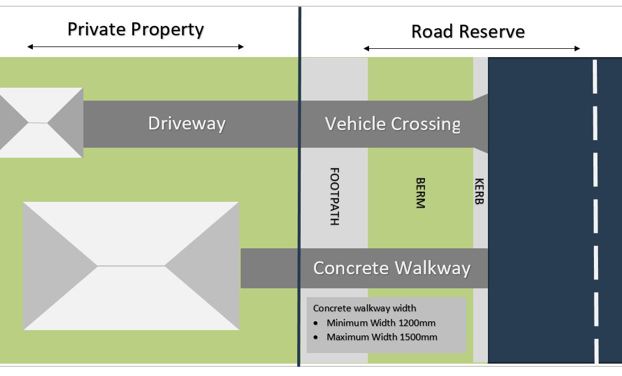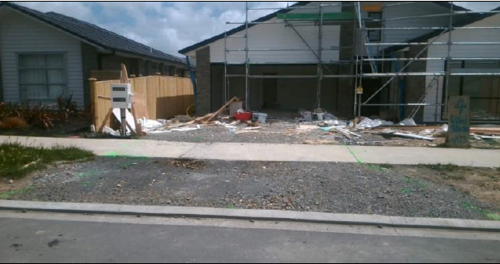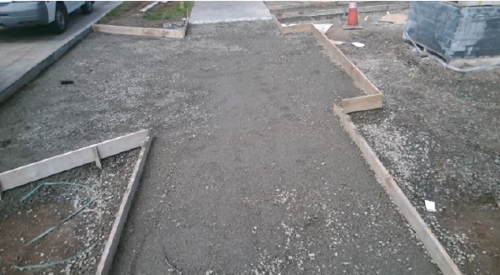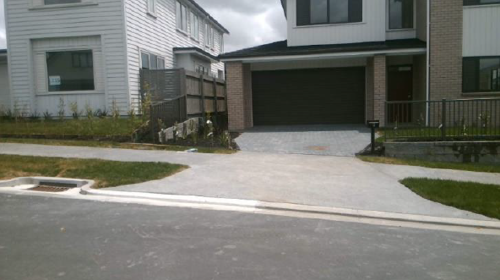Vehicle crossing application Vehicle crossing application
If you are planning to build or change a crossing, you must apply for a vehicle crossing application before you start.
Any vehicle crossings in existing roads within subdivision are to follow the vehicle crossing application process.
The vehicle crossing is the area of driveway between a public road and the private property boundary, usually replacing some of the public footpath.
Note: If you have received your written approval and are ready to book your vehicle crossing inspection - skip ahead to step 8 to access the online booking tool.

Do not submit a Vehicle Crossing Application in the following cases:
Land subdivision
Vehicle Crossings being built as part of a land subdivision are not covered by the Vehicle Crossing application process. In these cases, the consultants or contractors building the subdivision should contact Auckland Council to get the work approved.
Limited access roads (LAR)
If you are planning to build or change a driveway and you're on a limited access road, then you need to apply for an authorised crossing place.
Private road
A private road is a road that is formed on non-council land and owned or controlled by a private person, persons or body corporate. Maintenance of the private road is the responsibility of the person, persons or body corporate. Applying for a vehicle crossing through Auckland Transport on a private road is not required.
Some newly formed roads within new subdivisions are privately owned and therefore under Auckland Council.
Redundant crossing
Where a vehicle crossing is no longer required, the crossing or redundant section of the crossing must be reinstated as berm, footpath, kerb and channel where applicable as per AT standards. The costs of such work will be paid by the owner of the site previously accessed by the vehicle crossing.
Before you apply
Design the vehicle crossing
The design and construction of the driveway must comply with Auckland Council's Auckland Unitary Plan and AT vehicle crossing standards. You can design your vehicle crossing yourself, or you may wish to work with a consultant or contractor who can help ensure the design meets the necessary standards.
Some of the key designs for the vehicle crossings are:
- vehicle crossings must be at a 90 degree angle to the property boundary
- the standard vehicle crossing is 3m width at the boundary by 6.2m width at the road, for dimensions outside the standard please see Chapter E27 of the Auckland Unitary Plan - table E27.6.4.3.2.
Vehicle crossing standards
Auckland Transport released the current set of vehicle crossing standards on 15 June 2022, which apply to all of Auckland.
- Driveway gradients and standard car template (PDF, 44KB)
- Kerb and channel replacement standard (PDF, 40KB)
- Technical minimum standards (PDF, 446KB)
Residential vehicle crossings
- Residential Vehicle Crossing 1 (PDF, 168KB)
- Residential Vehicle Crossing 2 (PDF, 318KB)
- Residential Vehicle Crossing 3 (PDF, 393KB)
- Residential Vehicle Crossing 4 (PDF, 365KB)
- Typical Driveway Crossing 5 (PDF, 101KB)
Commercial vehicle crossings
- Commercial Vehicle Crossing 1 (PDF 139KB)
- Commercial Vehicle Crossing 2 (PDF 328KB)
- Commercial Vehicle Crossing 3 (PDF 404KB)
- Commercial Vehicle Crossing 4 (PDF 378KB)
- Typical Commercial Driveway Crossing 5 (PDF 101KB)
Rural vehicle crossings
- Rural Vehicle Crossing 1 (PDF 135KB)
- Rural Vehicle Crossing Zone Speed 2 (PDF 112KB)
- Rural Vehicle Crossing Zone Speed 3 (PDF 135KB)
Asphalt vehicle crossings
Concrete walkway
Please note that concrete walkways over the road corridor (including the berm) between the public footpath and the private property are considered encroachments under AT’s Activities in the Road Corridor Bylaw 2022. They are not AT assets and remain the responsibility of the property owner. You will need to apply for a minor encroachment approval.
Apply to work on or around a council tree
Contact an Auckland Council Urban Forest Specialist if your vehicle crossing will be within 3m of a street tree or within the Tree Protection Zone.
The protection of a public tree(s) near a proposed vehicle crossing may require significant changes to the design or layout of a project. We urge you to consult with the Urban Forest Team early.
Apply to work on or around a council tree through Auckland Council.
Find out if anything needs to be relocated in the street
Where possible, you should choose a location for your vehicle crossing that avoids interfering with existing features in the streets like fire hydrants, pedestrian crossings, and streetlights. If it's not possible to avoid features like these, you may need to request for them to be relocated.
Contact AT call centre if there are streetlights, cesspits, catchpits, kerb outlets, street parking lines, parking or bus stop signs, bus shelters, speed hump, pedestrian crossings, redundant vehicle crossings, crash barriers and refuge islands near your proposed vehicle crossing.
Contact the relevant utility (either Vector, Chorus, or Watercare) if there are street poles transformers, power or communication pits or pillars, drainage pits or manholes, or fire hydrants near your proposed vehicle crossing.
Contact LINZ if there are any survey markers near your proposed vehicle crossing.
Check if you also need a resource consent
You will need to apply for resource consent with Auckland Council if:
- you are planning to build a vehicle crossing that is wider than 3 metres at the boundary between the private property and the road reserve
- there are any trees within 3 metres of your proposed vehicle crossing location
- you are building a new house and there isn't a suitable existing vehicle crossing.
Vehicle crossing application and process
We aim to process your vehicle crossing application and deliver a consent letter to you within 20 working days. This includes processing time with both Auckland Council and AT.
Step 1: Prepare documents for your application
All vehicle crossing applications must include:
- a detailed plan showing all the property boundaries to scale, this could be an architect's plan
- a diagram showing the proposed vehicle crossing location in relation to the closest property boundary
- detailed photos of where your proposed vehicle crossing will be.
If there are any features in the street that may affect your proposed vehicle crossing (for example trees, power poles, streetlights, drainage pits) your vehicle crossing application must include:
- a plan showing the location of any relevant features
- detailed photos showing the location of any relevant features.
If your proposed vehicle crossing requires a resource consent, and to avoid delays, you may also need to include:
- approved resource consent decision and plans for vehicle crossing not complying with Auckland Unitary Plan or Hauraki Gulf District Plan
- approved resource consent decision and plans for trees or an asset owner approval.
Step 2. Register for the Road Services portal
Your application should be submitted using the application form in the Road Services portal.
To log in to AT's Road Services portal, you must first have a MyAT account.
If you have registered for an AT HOP card, Jetski, or AT Park account, you will have a MyAT account.
If you are an agent, you may wish to create a new MyAT account with your business email address.
Once you have registered and logged into your MyAT account, select 'all other services' then under 'vehicle crossing applications' select 'manage applications'. This will take you to the Road Services portal to complete and submit your application.
Step 3. Apply
Once you have logged into the Road Services portal, click 'vehicle crossing request', to fill out and submit an online vehicle crossing application form.
If you have problems logging in to the Road Services portal, please contact us.
The property owner is responsible for:
- ensuring your resource consent is approved or submitted before proceeding to apply for a vehicle crossing
- paying any required resource consent fees
- paying vehicle crossing application fees
- ensuring the information and documents submitted as part of the application are complete and correct
- ensuring the required inspections are carried out
- letting us know if any plans have changed once construction works begin
- ensuring a copy of the approval with special conditions and standards are provided to your contractor
- ensuring the vehicle crossing is constructed properly and complies with AT standards.
Safety
A safe worksite must be maintained and managed according to the Code of Practice for Temporary Traffic Management (COPTTM).
A temporary traffic and pedestrian management plan is required to manage the site during the entire construction of the vehicle crossing including unattended excavations.
Any unattended excavations must be made safe by laying compacted metal ramps or similar items on each side of your crossing to allow pedestrians through the site safely.
Step 4: Pay the application fee
After you submit your application via the Road Services portal, it will be assigned to Auckland Council to review. Once they have reviewed your application, you will receive an email from Auckland Council with online payment details.
There is a fixed application fee of $529 (including GST). This fee is effective from 1 July 2024.
The fee covers office processing charges and 3 field inspections:
- pre-approval inspection
- pre-pour inspection
- final reinstatement inspection.
All fixed charges are non-refundable and no additional charges will be applied.
Payment options
Auckland Council is the receiving agent for payments.
Once you receive the invoice from Auckland Council, you must pay by online banking.
Step 5. Auckland Council pre-approval
When you have paid the application fee, the pre-approval process will start at Auckland Council.
Auckland Council will then transfer your application to AT for a pre-approval inspection.
You do not need to do anything at this stage. You can check the progress of your application online by logging into the Road Services portal.
Step 6. AT pre-approval process
When Auckland Council has transferred your application to AT. We will check it complies with Chapter E27 of the Auckland Unitary Plan as well as all the technical standards and requirements. These include traffic safety sight distances, storm water control, maximum gradients, prevention of scraping, and location of power poles, trees, streetlights, signs, and other utility infrastructure.
Pre-approval inspection
You do not need to book in a pre-approval inspection. Once the road corridor inspector has received and reviewed your application, they will visit the proposed vehicle crossing location and advise in writing if your application has passed or failed.
If your application passes this inspection, AT will send you an approval letter giving you permission to begin construction, in accordance with detailed specifications that will be included with the letter.
AT will assess the level of temporary traffic management (TTM) required during the pre-approval site inspection. AT will request that you submit a traffic management plan before any works can take place. Details of how to submit a traffic management plan will be provided in the approval letter.

Image: Example of a vehicle crossing at the pre-approval stage.
Step 7. You can start work
Once the pre-approval inspection has passed, you will receive an approval letter by email letting you know you can start constructing your vehicle crossing. You must not start the work until you receive the approval letter.
Step 8. Book your pre-pour inspection
When the excavation has been prepared and ready for concrete to be poured, you must contact us to arrange an inspection of the boxing before the concrete is poured.
Please note that you must have received written approval from Auckland Transport before booking an inspection.
We require 2 working days' notice to arrange this inspection.
Auckland Transport has transitioned vehicle crossing applications and booking inspections to our new Road Services portal. This means that the process for booking vehicle crossing inspections is different depending on whether your application was submitted before or after 14 August 2023.
If you submitted your vehicle crossing application before 14 August 2023 you can do the following:
If you submitted your vehicle crossing application after 14 August 2023 you can book your vehicle crossing inspection via the new Road Services portal.
What happens next
Your booking request will be sent to your area road corridor inspector who will contact you to arrange a suitable time and date to carry out the inspection.
Once the pre-pour inspection has been passed, we will advise you that your crossing must be poured within 7 days (includes weekends and public holidays) and the boxing removed, topsoil and grass seed placed, and saw-cuts completed in the concrete.
It is not acceptable for the footpath and grass berm area to be disrupted and left in a dangerous state for a prolonged period of time.

Image: Example of a vehicle crossing at the pre-pour inspection stage.
Step 9. Book your final inspection
When your vehicle crossing is complete, you must book a final inspection. When we inspect your site, we will use a checklist to ensure the concrete is poured, the saw cuts completed, topsoil placed and compacted level with the footpath and crossing, grass seed sown, and all debris removed from the site.
We require 2 working days' notice to arrange this inspection.
Auckland Transport has transitioned vehicle crossing applications and booking inspections to our new Road Services portal. This means that the process for booking vehicle crossing inspections is different depending on whether your application was submitted before or after 14 August 2023.
If you submitted your vehicle crossing application before 14 August 2023 you can do the following:
If you submitted your vehicle crossing application after 14 August 2023 you can book your vehicle crossing inspection via the new Road Services portal.
What happens next
Your booking will be sent to your area road corridor inspector who will contact you to arrange a time and date for the inspection.
If the vehicle crossing passes the final inspection, you will receive a certificate of completion via email advising you the inspection has passed. A copy is sent to Auckland Council to update the Property File. You can also login to the Road Services portal at any time to retrieve your copy of the certificate of completion.
Only the consented parties, for example the applicant or nominated agent, listed on the application will receive a copy of the certificate of completion.

Image: Example of a vehicle crossing at the final inspection stage.
Step 10. On-going maintenance of your vehicle crossing
The property owner is responsible for the cost of constructing and maintaining the vehicle crossing serving their property, in accordance with the Auckland Transport activities on the road corridor 2024.
- If AT widens or realigns a road and these works require the vehicle crossing to be altered to meet the new road alignment, then AT will alter and reinstate the vehicle crossing access at our cost.
- On-going maintenance and repairs to the vehicle crossing remains the responsibility of the property owner.
- For rural properties with a culvert pipe under the vehicle crossing, the property owner is responsible for maintenance of the culvert to keep it free of debris that could block the culvert to cause it to overflow and cause flooding, or damage the road.
- Property owners are expected to maintain the berm (grass area) in front of their property to a reasonable standard, to ensure traffic visibility is not compromised, long grass does not become a fire hazard, and the area looks tidy.
- For any concerns about the way a street front is being maintained, visit berm maintenance.
The legal requirements surrounding the need to construct and maintain a vehicle crossing can be found in:
- Section 335 of the Local Government Act 1974 (New Zealand Legislation website).
- Auckland Transport's Activities in the Road Corridor Bylaw 2022